A hydraulic modular valve is a valve system composed of interchangeable sections or modules. These modules can be combined in various configurations to control multiple functions within a hydraulic circuit, including directional control, pressure control, and flow control. The modular design allows for easy assembly, disassembly, and customization to meet specific application needs.
These valves are widely used in industries such as manufacturing, construction, agriculture, and more, where flexibility, scalability, and precision control are critical.
Key Features of Hydraulic Modular Valves
Modular Design: Allows for easy customization and expansion to meet the specific needs of the hydraulic system.
Versatility: Capable of performing various functions, such as pressure control, flow control, and directional control, depending on the modules used.
Scalability: Can be adapted to larger systems by adding additional modules, making them ideal for complex machinery.
Compact Size: Despite their versatility, hydraulic modular valves are typically compact and space-efficient, making them suitable for systems with limited space.
Durability: Made from high-quality materials to withstand harsh conditions, including high pressures and extreme temperatures.
Types of Hydraulic Modular Valves
Hydraulic modular valves come in several types based on their function and application. The most common types include:
Directional Control Modular Valves:
These valves control the direction of fluid flow within the hydraulic circuit. Directional control valves can direct the flow to different parts of the system, such as cylinders or motors, to control the movement of machinery.
Pressure Control Modular Valves:
Pressure control valves are used to regulate or limit the pressure within a hydraulic system. These valves can include pressure relief valves, pressure reducing valves, and unloading valves to protect the system from overpressure and ensure stable operation.
Flow Control Modular Valves:
Flow control valves are responsible for controlling the flow rate of hydraulic fluid. By adjusting the flow, these valves ensure that components such as actuators or motors receive the proper amount of fluid to perform their tasks efficiently.
Check Valves:
Check valves prevent backflow in the system, ensuring that fluid flows in one direction only. This is essential in maintaining the integrity and efficiency of the hydraulic system.
Combining Modules:
A combination of different modules can be assembled to create a valve system that controls both flow, pressure, and direction. This flexibility allows engineers to design hydraulic systems that are highly efficient and tailored to the specific needs of the application.
How Hydraulic Modular Valves Work
Hydraulic modular valves operate by regulating the flow of hydraulic fluid through various interconnected modules. Each module performs a specific function, such as controlling pressure, direction, or flow rate. These modules are connected in series or parallel configurations to form a complete valve system that can perform multiple tasks simultaneously.
The modules can be activated individually or in combination, depending on the needs of the system. For example, the directional control valve can direct fluid to a specific component, while the pressure control valve ensures that the system operates within safe pressure limits. The modular design allows for easy modifications and upgrades as the system requirements evolve.
Advantages of Hydraulic Modular Valves
Customization and Flexibility: Modular valves offer a high degree of flexibility, allowing systems to be easily customized or reconfigured as needed.
Cost-Effective: Rather than replacing an entire valve system, individual modules can be replaced or upgraded, reducing maintenance costs.
Compact and Space-Saving: Modular valves are typically compact and take up less space, making them ideal for systems with limited installation space.
Easier Maintenance: With modular construction, maintenance is simplified. Components can be easily accessed and replaced without disassembling the entire system.
Increased Efficiency: These valves provide precise control over hydraulic systems, improving overall system efficiency and performance.
Applications of Hydraulic Modular Valves
Hydraulic modular valves are used across a wide range of industries and applications, including:
Construction Equipment: In machinery like bulldozers, excavators, and cranes, modular valves control various hydraulic functions, including steering, lifting, and digging.
Agriculture: Tractors and harvesters use modular valves to control implements and manage the movement of hydraulic cylinders and motors.
Industrial Machinery: Modular valves are used in presses, injection molding machines, and conveyor systems for controlling fluid flow, pressure, and actuator movement.
Automotive: Used in power steering systems, hydraulic brakes, and other applications requiring fluid control.
Marine: In boat steering systems, winches, and other hydraulic functions, modular valves ensure precise control and efficient operation.
Oil & Gas: Used in drilling rigs, pumps, and other equipment requiring reliable hydraulic control.
How to Choose the Right Hydraulic Modular Valve
Selecting the right hydraulic modular valve depends on various factors, such as:
System Requirements: Determine what functions your system needs (directional control, pressure control, flow control, etc.).
Flow and Pressure Ratings: Ensure the valve can handle the required flow rates and pressures for your system.
Porting Configuration: Check the port size and configuration to ensure compatibility with your hydraulic system.
Valve Type: Choose the right type of valve for your specific application (e.g., directional control, pressure relief, flow regulation).
Environment: Consider the working environment, including temperature, humidity, and exposure to harsh conditions, to select materials and seals that can withstand these conditions.
- Product Details
- Brand :
- Place of Origin : Not Given
- FOB Price : On Request
- Minimum Order Quantity : Not Given
- Supply Ability :
- Packaging & Delivery
- Packaging Detail : Not Given
- Delivery Detail : Not Given
Not Given















